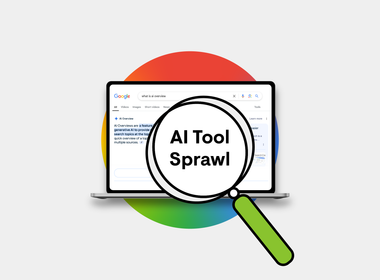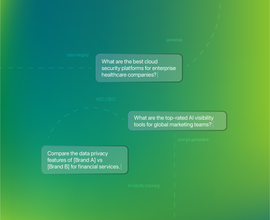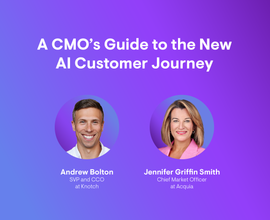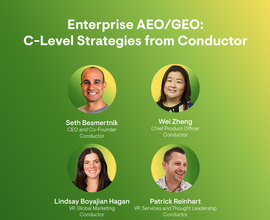What is AEO Tool Sprawl & How to Overcome It?
Thanks to the rise of AI, the search landscape is evolving faster than ever before. Traditional SEO has largely been replaced by answer engine optimization (AEO) and generative engine optimization (GEO). This shift means that instead of just ranking for keywords, brands need to optimize their content to be directly cited, mentioned, and leveraged by AI answer engines like ChatGPT , Perplexity , and Google's AI Overviews.
As this new frontier emerges, a new set of specialized tools designed to help marketers navigate it have emerged too.
While these AEO tools offer powerful capabilities, from AEO visibility to content generation to technical monitoring, their rapid surge in popularity has contributed to a new challenge for marketers: AEO / GEO tool sprawl. With the industry moving so quickly and digital leaders trying to adapt, this has caused many brands to onboard tools as quickly as possible without fully evaluating the need and potential impact.This tool sprawl creates inefficiencies, obscures critical insights, and ultimately limits a brand's ability to truly maximize its AI search visibility and growth potential.
What is AEO tool sprawl?
AEO / GEO tool sprawl refers to the accumulation of multiple, often disconnected, software solutions used to manage various aspects of AEO and AI search visibility. In the race to adapt to AI-driven search, many organizations adopt a patchwork of point solutions, each designed to address a specific need.
As AI models and answer engines become more sophisticated, new point solutions hit the market geared towards:
- AI content generation & optimization
- AI visibility tracking
- Structured data implementation
- Topic and keyword research
- Technical website monitoring
Each point solution might offer a valuable feature or capability, but relying on a disparate toolset creates complex and fragmented workflows. Teams wind up juggling multiple logins, exporting and importing data, and struggling to piece together a cohesive picture of their digital performance. And all of that comes with a cost, both in time and budget, after all these tools are usually expensive.
Why is AEO tool sprawl an important consideration?
AEO tool sprawl is more than just an inconvenience; it brings significant challenges that can directly impact a brand's digital growth, team efficiency, and budgetary constraints.
It really comes down to analysis paralysis. You can't use everything. At some point, you have to just say ‘this is what works for us from a visibility standpoint.’
For SEOs, content marketers, web teams, eCommerce professionals, and digital marketing leaders, understanding these implications is crucial for making strategic decisions.
I talk to so many CMOs and so many businesses, and they say, ‘Oh my god, another tool for AI. Why do we need so many tools?’ For many companies, limited budget, limited time to audit, and the procurement process are so time-consuming that I generally think that people would prefer to leverage fewer tools if they could because evaluating all these tools takes time, takes energy.
Visibility concerns from tool sprawl
In the world of AI search, whether your brand and content are visible is essential for your presence and growth. But a fragmented tool stack can severely limit your ability to truly see and understand your performance.
- Fragmented data and incomplete insights: When data is scattered across multiple platforms, it’s almost impossible to get a holistic view of your AI search performance. One tool might track keyword rankings, another might monitor AI Overviews, and another might analyze user behavior, leaving you to connect these dots to understand the full customer journey.
- Difficulty tracking AI overviews and LLM citations: Answer engines often pull information from various sources to provide direct answers or summaries. Tracking which content of yours is being cited by these LLMs, or appearing in AI Overviews, becomes incredibly challenging with disparate tools, leaving you to guess how you appear in AI search.
- Limited understanding of user intent: AI search is highly conversational and intent-driven. To optimize for AEO / GEO, you need deep insights into what users are asking, the nuances of their queries, and the context behind their questions. When your research, content, and performance data are siloed, it’s a challenge to get a full understanding of user intent across different AI platforms and traditional search engines.
- Impact on brand visibility and authority: In the AI era, demonstrating expertise, experience, authoritativeness, and trustworthiness (E-E-A-T ) is more important than ever. If you can’t consistently track how your content is being consumed and cited by AI, you lose the ability to strategically build and maintain your brand's reputation as a trusted source of information.
Process and workflow concerns
Beyond visibility, AI search tool sprawl creates significant operational hurdles that slow down teams and reduce overall productivity.
- Inefficient workflows and manual processes: Imagine an SEO manager needing to pull keyword data from one tool, content performance from another, and technical insights from a third, then manually combining them in a spreadsheet to identify optimization opportunities. This is the reality of tool sprawl.
- Collaboration challenges across teams: Modern digital marketing requires seamless collaboration between SEOs, content marketers, web developers, and product teams. When each team uses its own disconnected tools, sharing insights and aligning on strategies becomes a nightmare.
- Slow decision-making: Tool sprawl means that gathering the necessary data for informed decision-making is a tedious, time-consuming process.
- Difficulty scaling AEO efforts: For enterprise organizations operating across multiple markets, brands, or product lines, scaling enterprise AEO efforts with a fragmented tool stack is nearly impossible. Each new market or brand adds another layer of complexity, more tools, and more data silos. This makes it challenging to maintain consistent strategies, ensure compliance, and achieve unified performance across the entire digital footprint.
You're not going to be able to get anything done if you are leveraging too many tools, because you're going to have trouble connecting the dots, and you're actually going to wind up moving slower. For me, less is more.
Budgetary and financial concerns
The hidden costs of tool sprawl can quickly eat into marketing budgets and make it difficult to prove the financial impact of your initiatives.
- Redundant subscriptions and licenses: The most obvious financial downside of tool sprawl is the cost of multiple, overlapping subscriptions. Organizations often pay for similar functionalities across different tools because no single solution provides a comprehensive answer, which leads to unnecessary spend and reduced ROI.
- Hidden costs of integration and maintenance: Beyond subscription fees, there are other hidden costs associated with managing a sprawling tool stack. These include the time and resources spent on integrating disparate systems, training employees on multiple interfaces, and ongoing maintenance to ensure data consistency and tool compatibility.
- Difficulty proving ROI: With fragmented data, it becomes incredibly difficult to tie specific actions to measurable business outcomes like revenue, customer acquisition, or brand awareness.
- Low budget influence for practitioners: When ROI is unclear, practitioners like SEO managers and content strategists often struggle to advocate for the resources they need. Their efforts might be impactful, but without a unified view of performance and a clear path to demonstrating ROI, their influence on budget can be reduced.
Ultimately, tool sprawl leads to siloed data, inefficient workflows, and increased operational costs, ultimately undermining the very goal of improved AI search visibility.
How to overcome AEO tool sprawl
Overcoming AEO tool sprawl requires a strategic shift from leveraging a collection of point solutions, like Profound, Jasper AI, and Writer AI, to a unified, integrated platform approach. This means seeking out solutions that offer comprehensive capabilities, purpose-built AI, and enterprise-grade features designed to streamline workflows and provide a single source of truth for all your website optimization and intelligence needs.
For example, Conductor is an all-in-one platform that allows you to oversee and optimize every aspect of your site’s AI performance in one place. With Conductor, you can pinpoint topics to cover to improve your brand authority, then seamlessly generate on-brand content that is optimized to perform in AI search, and then measure and monitor your content after publishing to ensure it’s performing as expected.
We have examples of the strain of disparate solutions in our lives. Like everyone uses Salesforce , now they need to connect Salesforce data to Marketo . Then connect that to Gong and so on. You’re just constantly in the integration soup.And that's why you need to think about an all-in-one platform.
Maybe your all-in-one platform doesn't have all the bells and whistles of all the different tools put together, but it gets some of the things so right that it saves you the headache of having to integrate the data in all the different disparate tools.
Cut down on AEO Tool Sprawl and learn which AI visibility platform is best for growing your brand’s digital presence with our comprehensive evaluation guide.
The benefits of consolidating AEO tools
Consolidating your AEO tools into a single, powerful enterprise AEO platform offers a multitude of benefits that directly address the challenges posed by tool sprawl.
- Enhanced AI search visibility
- Streamlined workflows
- Data-driven decisions
- Seamless cross-functional collaboration
- Improved ROI
- Reduced costs
- Future-proofing your strategy
Overcoming AI tool sprawl in review
The rise of AEO presents new opportunities for brands to increase their visibility and connect with audiences in new ways, but the growth in the number of AEO tools can lead to significant challenges, including fragmented visibility, inefficient workflows, and escalating costs. This AEO tool sprawl prevents enterprises from fully realizing their growth potential in AI search.
By strategically consolidating AEO tools into a unified, enterprise-grade platform, organizations can overcome these hurdles. This approach delivers enhanced AI search visibility, streamlines operations, empowers data-driven decision-making, fosters cross-functional collaboration, and ultimately maximizes the return on investment for all digital marketing efforts.
FAQs
- What is AI optimization (AIO)?
- What are content guardrails?
- How do you increase brand mentions and citations in AI?
- What is AEO?

![Patrick Reinhart, VP, Services and Thought Leadership, [object Object]](https://cdn.sanity.io/images/tkl0o0xu/production/9bc72298b24ad01b732de4c3376f79546d20f81c-3542x3542.png?fit=min&w=100&h=100&dpr=1&q=95)
![Wei Zheng, Chief Product Officer, [object Object]](https://cdn.sanity.io/images/tkl0o0xu/production/dcfa62c0fe34ba0c31f910b818874cd160ad8839-3542x3542.png?fit=min&w=100&h=100&dpr=1&q=95)






